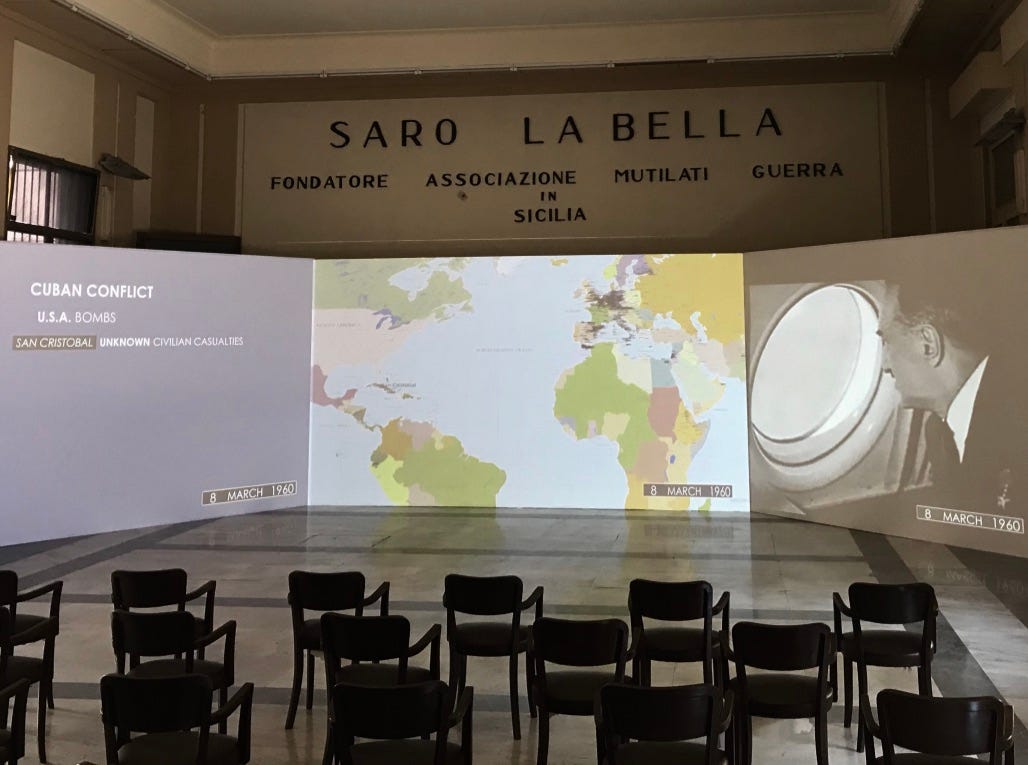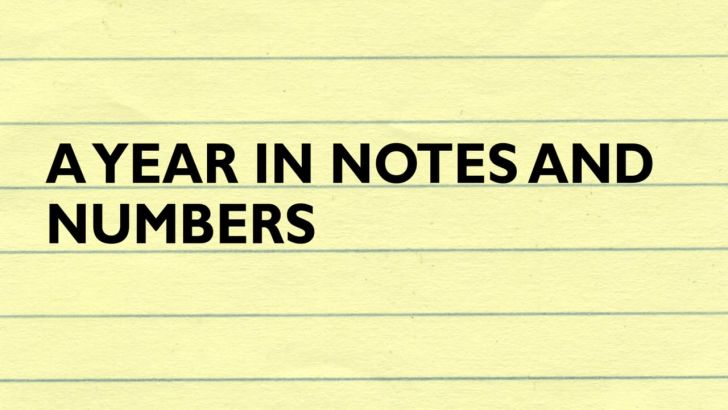A Year in Notes and Numbers (2017) is a 4 minute silent digital video work by the American experimental filmmaker Lynne Sachs, which consists of close-up shots of a few words from to-do lists and notes to self, mostly written on yellow ruled paper, with names, errands and artistic intentions written in various coloured inks, circled, crossed out, stained, creased, blotted: “Write Mom / to thank!”; “Vitamin D”; “FROGS”; “Make 2 shelves / Build 2 shelves”; “lightbulbs”. These lists are occasionally overlaid with medical terms and measurements: “Sodium / 138”; “Globulin / 2.6”; “eGFR / 86”. At one point a section from the production notes of what is probably one of Sachs’ other films is shown: “She observes herself / and others // learning”. The next shot: “Camera as extension of her body.” The next shot: “Fun of research.” We see the minutiae of a year in a life, the endless small tasks that demand to be completed, correspondence that needs to be written, plans and ideas for projects that might or might not be realised; we also see the medical quantification of the body which performs these tasks. There are personal reminders: “Write Barbara H” (Barbara Hammer, presumably); there are political reminders: “Get out the vote”. It ends with the word “Mom”, then the figure “125 LBS”, then a few seconds of swirling reds, yellows and greys.
A Year in Notes and Numbers relates to a strand in Sachs’ earlier work, which goes right back to one of her earliest films, Still Life with Woman and Four Objects (1986). These pieces are distinct from, but related to, the experimental documentaries about political history which Sachs has also made, and focus more closely on everyday life and its reproduction. In Still Life with Woman and Four Objects—a tribute to the anarchist and feminist Emma Goldman—a woman puts on a coat, peels and pits an avocado, suspends the stone above a glass of water to sprout it, eats a meal, and reads aloud a letter of Goldman’s. Food preparation, small acts of gardening, eating and anarcha-feminism all sit on the same level. This strand of Sachs’s work is perhaps best represented in a piece like Window Work (2000), a 9 minute sound video comprising of a single uninterrupted shot of a kitchen window in Baltimore, in which a women washes the windowpane, makes and drinks some tea, reads the newspaper. Two small frames within the larger image show miniature home-movies, which gesture towards personal memory and earlier media technologies: Super 8 film as the precursor to videotape. Window Work could be read as a kind of Jeanne Dielman (Chantal Akerman, 1975) in miniature; though where Chantal Akerman shows the drudgery and tedium of housework with an unflinching clarity, in Sachs’ film the accoutrements of domesticity are shown in shadow and used to evoke a dream-like atmosphere which encourages fantasy and reverie on the viewer’s part. Jeanne Dielman tries to make housework visible, or at least questions to what extent labour can be made visible through cinema, and in doing so, demands work from the viewer, who must pay attention, sitting through its lengthy run-time and long, slow takes. Sachs’ Window Work, on the other hand, is more playful with the concept of work—does the “work” in the title refer to the work of cleaning the window, in a fairly desultory fashion, or to the artwork we are watching? Is the work of this film a dreamwork?
In contrast to these earlier explorations of the everyday and domestic in Sachs’ oeuvre, A Year in Notes and Numbers is mundane on a different level. By showing names, tasks, numbers and stray thoughts completely devoid of any context, with no date or other clue as to what they mean, a year is condensed to a flurry of seemingly meaningless activity, combined with the equally decontextualised and slightly ominous medical statistics that appear intermittently on screen. Calcium: 9.6. Is this good or bad? Sinister or reassuring? What about Bilirubin 0.7? (According to Google, both of these figures are within the average range.) By reducing the representation of a body to written memoranda and biological measurements, this recent work by Sachs is somehow both more personal and more alienating than her earlier work dealing with similar topics. The body is reduced to a quantum of figures, abstracted into data, but not at the expensive of the person who that body is, who has family and friends to write to, lightbulbs to buy, DVDs to watch, interviews to listen to, films to make.
Unending Lightning (2015–ongoing) is a six-plus hour three-channel video installation by the Spanish artist Cristina Lucas which documents every aerial bombing over civilians since the development of manned flight. It visualises a database gathered by a large number of researchers and organisations, building on research begun in 2011, on the 75th anniversary of Guernica, arguably—thanks to Picasso—the most famous aerial bombing of civilians. Manned flight was made possible in 1903. By 1909, two people could fly in one aircraft. Aerial bombing began only two years later, in the 1911 Italo-Turkish war, a war over colonial control of Libya. Unending Lightning is an ongoing work, because it will only be complete when aerial bombing over civilians, including drone strikes, is a military strategy that has been abandoned. The central screen shows a map of the world with the locations of the bombings and the number of civilian casualties marked; the left screen shows the respective military forces responsible for dropping the bomb, the type of bomb dropped, the city bombed and the known number of casualties; the right screen shows archive and documentary videos and photography from the aftermath of the bombings. I saw it at Manifesta 12 in Palermo, where it was shown in the Casa del Mutilato, a hospital for wounded soldiers designed by the Rationalist (i.e. Fascist) architect Guiseppe Spatrisano in 1936: a large temple to fascism erected in honour of the Italian annexation of Ethiopia in the same year—a conflict which saw Italy using poison gas bombs on Red Cross hospitals. As Sven Lindqvist argued in A History of Bombing, in its first years aerial bombing was seen as a convenient and exciting answer to the question of how exactly European powers could exterminate entire populations without having to get their hands quite so dirty. The origin of this technology lies in colonial violence.

Unending Lightning is a magisterial work, one requiring a collaborative team of researchers and software engineers, the accumulation and maintenance of large amounts of historical data; it is open-ended and so almost unwatchable as a single piece, with a runtime which grows with each new drone strike in Afghanistan (almost 40 per day in September 2019 alone, according to The Bureau of Investigative Journalism). The visual aesthetics of Unending Lightning resemble nothing more than a PowerPoint presentation: bullet-pointed information presented in Helvetica on grey-blue backgrounds, grainy historical photographs gradually improving in quality as the work moves closer to recent bombings and the video and photography technologies which captured the aftermaths develop. While watching it, the viewer sees the unceasing global conflicts which have unfolded over the last century and more. Near the beginning of the film there are a few moments where days go by in which no aerial bombings take place, but soon it is every day, all over the globe, often accompanied by the phrase “unknown numbers of civilians killed”. Even with the enormous amount of research undertaken for the work, we will never be able to truly know through quantification the amount of death unleashed on the world by the advent of bombing from the air.

What does Unending Lightning have to do with Lynne Sachs? At first glance perhaps very little. But they operate at different ends of the same recent aesthetic tendency, exploring quantification and its limitations. In Lucas’ work, we watch something unfold which feels like an unending depiction of death and destruction, mostly of women and children; what necessarily gets left out of the work, and as such is brought concertedly to mind when we view the piece, are the actual everyday lives of the people who were killed by these bombs dropped from the air. In Sachs’ recent work, on the other hand, the abstraction of a life from a record of its daily activities asks the viewer to fill in the gaps, to imagine or project something into the space that is left open between the unfinished errands and the medical figures we are presented with. In very different ways both artists are concerned with the everyday, the way that developments in technology can start to feel familiar, natural, normal, until all of a sudden they don’t, and they erupt into the sphere of domesticity, whether that’s through the collection and retention of biological data by private healthcare companies, or the firing of a missile from a remote-controlled drone.



